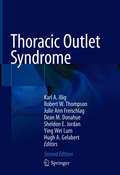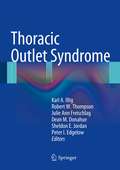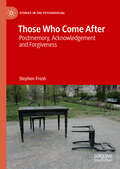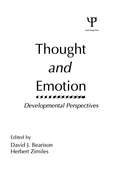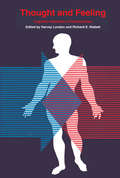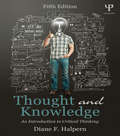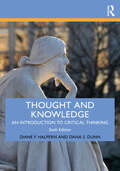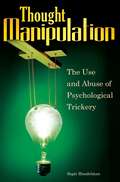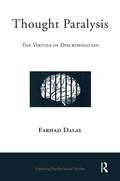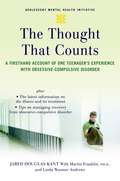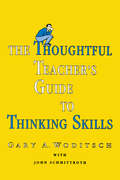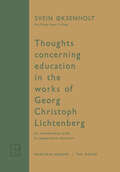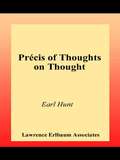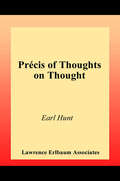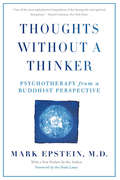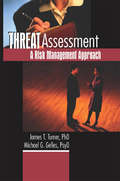- Table View
- List View
Thoracic Outlet Syndrome
by Karl A. Illig Robert W. Thompson Julie Ann Freischlag Dean M. Donahue Sheldon E. Jordan Ying Wei Lum Hugh A. GelabertThis extensively revised edition is an essential reference for physicians involved in the diagnosis, referral and treatment of the thoracic outlet syndrome (TOS). TOS is made up of a constellation of problems resulting from pathology at the thoracic outlet in the neck. Busy specialty practice sees multiple affected patients in every clinic, but TOS can often be difficult to diagnosis. Thoracic Outlet Syndrome explores all possible ancillary care issues surrounding this complex condition, including rehabilitation, disability, natural history and medicolegal issues, and aims to stimulate research, discussion and a sense of community between professionals involved in this area. Vascular and thoracic surgeons, neurosurgeons, neurologists, psychiatrists and psychologists, physical therapists, occupational medicine specialists and pain specialists will find this book a must read for successful treatment, referral and diagnosis of TOS in clinical practice.
Thoracic Outlet Syndrome
by Karl A. Illig, Robert W. Thompson, Julie Ann Freischlag, Dean M. Donahue, Sheldon E. Jordan and Peter I. EdgelowThoracic Outlet Syndrome is an essential reference for physicians involved in the diagnosis, referral and treatment of the condition. Thoracic outlet syndrome (TOS) is made up of a constellation of problems resulting from pathology at the thoracic outlet in the neck. Busy specialty practice see multiple affected patients in every clinic, however TOS can often be difficult to diagnosis. This book explores all possible ancillary care issues surrounding this complex condition, including rehabilitation, disability, natural history, and medicolegal issues, and aims to stimulate research, discussion, and a sense of community between professionals involved in this area. Vascular, thoracic, and neurosurgeons, neurologists, psychiatrists and psychologists, physical therapists, occupational medicine specialists, and pain specialists alike, will find this book to be a must have for successfully treating, referring and diagnosing TOS in clinical practice.
Those Who Come After: Postmemory, Acknowledgement and Forgiveness (Studies in the Psychosocial)
by Stephen FroshThis book explores the legacies of suffering in relation to ‘those who come after’ – the descendants of victims, survivors and perpetrators of traumatic events. It draws on recent discussions of ‘postmemory’ and ‘haunting’ that are concerned mainly with the transgenerational impact of personal and social trauma. It examines how we are connected to past events for which we have no direct responsibility yet in which we might in some way be ‘implicated’ and it asks how we might attain a position of active witnessing that helps resolve the suffering of others. Those Who Come After includes vivid accounts of witnessing from a variety of perspectives, ranging from Biblical and Jewish stories to contemporary art and music. The book draws on psychosocial studies and psychoanalysis to help make sense of this material and to develop an understanding of acknowledgment and responsibility that is both ethical and emancipatory. Those Who Come After will be of great interest to readers in psychosocial studies and psychoanalysis and to all who are concerned with the question of how to put past suffering to rest.
Thought and Emotion: Developmental Perspectives (Jean Piaget Symposia Series)
by D. J. Bearison H. ZimilesFirst published in 1985. Routledge is an imprint of Taylor & Francis, an informa company.
Thought and Emotion: Developmental Perspectives (Jean Piaget Symposia Series)
by David J. Bearison Herbert ZimilesFirst published in 1985. Routledge is an imprint of Taylor & Francis, an informa company.
Thought and Feeling: Cognitive Alteration of Feeling States
by Harvey London Richard E. NisbettRecently there has been growing awareness and acceptance of the proposition that people do not exist in a world of physically defined forces and events, but in a world defined by their own perceptions, cognitions, conclusions, and imaginations. We respond and react not to some objectively defined set of stimuli, but to our own apperceptions of stimuli that we define subjectively. The original essays in this volume center on one aspect of this process of attribution: The extent to which the perception of events and causes results in the determination, modification, or alteration of emotions, feelings, and affective states.This book is divided into five sections, each of which elucidates and extends these theoretical conceptions. Part 1 provides a historical background and analytical framework for the rest of the book. Part 2 presents chapters dealing with the sorts of internal cues which may give rise to a feeling state. Part 3 presents a chapter discussing the evaluative needs aroused by the internal cues. Part 4 is concerned with the process of explanation triggered by the evaluative needs. Part 5 deals with various external cues and how they are used to label the internal feeling state. There is a concluding discussion of the cognitive alteration of feeling states.The authors deal with aggression, boredom, obesity, the control of pain, and delusional systems. This volume is of continuing importance to clinical and experimental psychologists as well as social psychologists. Each of the authors takes the theoretical concept of cognition and relates it to research in biofeedback, physiology, social psychology, altered states of consciousness, etc. Thus, the book bridges the gap between cognitive theory and the use of that theory in applied research.
Thought and Feeling: Cognitive Alteration of Feeling States
by Richard E. NisbettRecently there has been growing awareness and acceptance of the proposition that people do not exist in a world of physically defined forces and events, but in a world defined by their own perceptions, cognitions, conclusions, and imaginations. We respond and react not to some objectively defined set of stimuli, but to our own apperceptions of stimuli that we define subjectively. The original essays in this volume center on one aspect of this process of attribution: The extent to which the perception of events and causes results in the determination, modification, or alteration of emotions, feelings, and affective states.This book is divided into five sections, each of which elucidates and extends these theoretical conceptions. Part 1 provides a historical background and analytical framework for the rest of the book. Part 2 presents chapters dealing with the sorts of internal cues which may give rise to a feeling state. Part 3 presents a chapter discussing the evaluative needs aroused by the internal cues. Part 4 is concerned with the process of explanation triggered by the evaluative needs. Part 5 deals with various external cues and how they are used to label the internal feeling state. There is a concluding discussion of the cognitive alteration of feeling states.The authors deal with aggression, boredom, obesity, the control of pain, and delusional systems. This volume is of continuing importance to clinical and experimental psychologists as well as social psychologists. Each of the authors takes the theoretical concept of cognition and relates it to research in biofeedback, physiology, social psychology, altered states of consciousness, etc. Thus, the book bridges the gap between cognitive theory and the use of that theory in applied research.
Thought and Knowledge: An Introduction to Critical Thinking
by Diane F. HalpernThis best-selling textbook, written by award-winning educator and past president of the American Psychological Association, Diane F. Halpern, applies theory and research from the learning sciences to teach students the thinking skills they need to succeed in today's world. This new edition retains features from earlier editions that have helped its readers become better thinkers. A rigorous academic grounding based in cognitive psychology is presented in a clear writing style with a humorous tone and supported by numerous practical examples and anecdotes. Thought and Knowledge, Fifth Edition has been revised to help students meet the challenges of a global neighborhood and make meaningful conclusions from the overwhelming quantity of information now available at the click of a mouse. The skills learned with this text will help students learn more efficiently, research more productively, and present logical, informed arguments. Thought and Knowledge, Fifth Edition is appropriate for use as a textbook in critical thinking courses offered in departments of psychology, philosophy, English, humanities, or as a supplement in any course where critical thinking is emphasized.
Thought and Knowledge: An Introduction to Critical Thinking
by Diane F. HalpernThis best-selling textbook, written by award-winning educator and past president of the American Psychological Association, Diane F. Halpern, applies theory and research from the learning sciences to teach students the thinking skills they need to succeed in today's world. This new edition retains features from earlier editions that have helped its readers become better thinkers. A rigorous academic grounding based in cognitive psychology is presented in a clear writing style with a humorous tone and supported by numerous practical examples and anecdotes. Thought and Knowledge, Fifth Edition has been revised to help students meet the challenges of a global neighborhood and make meaningful conclusions from the overwhelming quantity of information now available at the click of a mouse. The skills learned with this text will help students learn more efficiently, research more productively, and present logical, informed arguments. Thought and Knowledge, Fifth Edition is appropriate for use as a textbook in critical thinking courses offered in departments of psychology, philosophy, English, humanities, or as a supplement in any course where critical thinking is emphasized.
Thought and Knowledge: An Introduction to Critical Thinking
by Diane F. Halpern Dana S. DunnThought and Knowledge applies theory and research from the learning sciences to teach students the critical thinking skills that they need to succeed in today’s world. The text identifies, defines, discusses, and deconstructs contemporary challenges to critical thinking, from fake news, alternative facts, and deep fakes, to misinformation, disinformation, post-truth, and more. It guides students through the explosion of content on the internet and social media and enables them to become careful and critical evaluators as well as consumers. The text is grounded in psychological science, especially the cognitive sciences, and brought to life through humorous and engaging language and numerous practical and real-world examples and anecdotes. This edition has been streamlined with thoughtful consideration over what content to keep, what to cut, and how much new and current research to add. Critical thinking skills are presented in every chapter, empowering students to learn more efficiently, research more productively, and present logical, critical, and informed arguments. The skills are reviewed at the end of the chapter, and a complete list of skills with definitions and examples are included in the appendix. The text is supported by a companion website that features a robust set of instructor and student resources: www.routledge.com/cw/halpern. Thought and Knowledge can be used as a core text in critical thinking courses offered in departments of psychology, philosophy, English, or across the humanities and social sciences, or as a supplement in any course where critical thinking is emphasized.
Thought and Knowledge: An Introduction to Critical Thinking
by Diane F. Halpern Dana S. DunnThought and Knowledge applies theory and research from the learning sciences to teach students the critical thinking skills that they need to succeed in today’s world. The text identifies, defines, discusses, and deconstructs contemporary challenges to critical thinking, from fake news, alternative facts, and deep fakes, to misinformation, disinformation, post-truth, and more. It guides students through the explosion of content on the internet and social media and enables them to become careful and critical evaluators as well as consumers. The text is grounded in psychological science, especially the cognitive sciences, and brought to life through humorous and engaging language and numerous practical and real-world examples and anecdotes. This edition has been streamlined with thoughtful consideration over what content to keep, what to cut, and how much new and current research to add. Critical thinking skills are presented in every chapter, empowering students to learn more efficiently, research more productively, and present logical, critical, and informed arguments. The skills are reviewed at the end of the chapter, and a complete list of skills with definitions and examples are included in the appendix. The text is supported by a companion website that features a robust set of instructor and student resources: www.routledge.com/cw/halpern. Thought and Knowledge can be used as a core text in critical thinking courses offered in departments of psychology, philosophy, English, or across the humanities and social sciences, or as a supplement in any course where critical thinking is emphasized.
Thought Manipulation: The Use and Abuse of Psychological Trickery (Non-ser.)
by Sapir HandelmanThis thoroughly intriguing volume explains the many ways our thoughts are manipulated through temptation, distraction, misdirection, and more.From politics to sales, education, romance, and parenthood, everyone plays—wittingly or not—the roles of manipulator or manipulated. Thought Manipulation: The Use and Abuse of Psychological Trickery offers a thorough understanding of the art of manipulation, leading readers on a fascinating journey into the gray areas of ethics, politics, leadership, advertising, psychotherapy, and intimate relationships. The book explains how manipulation works, exploring morally questionable tricks, such as temptation, distraction, and misdirection and introducing manipulative strategies, both simple and sophisticated. At the same time, the author allows that manipulation is not always a bad thing as any effective change in decision-making and human behavior cannot be achieved without employing it to at least a certain degree. Manipulation operates in an infinite variety of guises and situations. Sapir Handelman explains how we can resist such effects, with a focus on ethics and freedom of choice.
Thought Paralysis: The Virtues of Discrimination (The\exploring Psycho-social Studies Ser.)
by Farhad DalalGiven the enormous struggles, efforts and money expended on the equalities enterprise, why has more progress not been made? And further, why have things actually become worse in some circumstances? It is argued this has occurred because:- The values of Equality have been bureaucratized, allowing the liberal principle of "live and let live" to be perverted and put in the service of fear and control.- The Diversity discourse has been hijacked by the libertarians and put in the service of increasing profit, under the guise of liberty and inclusivity.- The equality movements have become apolitical, sidetracked into the project of the indiscriminate celebration and preservation of cultures, in lieu of challenging the status quo within cultures as much as between them.- The versions of psychology and sociology that the equality movements have drawn on are over simple
Thought Paralysis: The Virtues of Discrimination
by Farhad DalalGiven the enormous struggles, efforts and money expended on the equalities enterprise, why has more progress not been made? And further, why have things actually become worse in some circumstances? It is argued this has occurred because:- The values of Equality have been bureaucratized, allowing the liberal principle of "live and let live" to be perverted and put in the service of fear and control.- The Diversity discourse has been hijacked by the libertarians and put in the service of increasing profit, under the guise of liberty and inclusivity.- The equality movements have become apolitical, sidetracked into the project of the indiscriminate celebration and preservation of cultures, in lieu of challenging the status quo within cultures as much as between them.- The versions of psychology and sociology that the equality movements have drawn on are over simple
Thought Suppression (ISSN)
by Eric RassinIs it possible to ban unwanted thoughts from consciousness? According to the literature on thought suppression, the answer is no. In the 1980s, Wegner and colleges demonstrated that the average person cannot prevent a trivial thought like that of a polar bear from entering consciousness approximately seven times in a five minute period. This experimental finding was followed by a substantial number of replications. This book provides an up-to-date overview of the thought suppression literature. First, similarities and differences between suppression, repression, and dissociation are discussed. Methodological issues are then considered. Finally, the clinical applications of the thought suppression literature are discussed. Although there are numerous conditions to which the phenomenon of suppression can be applied, obsession and traumatic recollection are the main applications. In addition to offering an overview of the literature, this book links the thought suppression paradigm to other research fields, such as directed forgetting and repressive coping. Furthermore, it discusses the phenomenon of thought suppression in the light of broader theories such as the cognitive theory of obsession, and the ego depletion hypothesis. Clinical implications and directions for future research are offered.
The Thought that Counts: A Firsthand Account of One Teenager's Experience with Obsessive-Compulsive Disorder (Adolescent Mental Health Initiative)
by Jared Kant Martin Franklin Linda Wasmer AndrewsFor the more than 2 million Americans with obsessive-compulsive disorder, the intrusive thoughts and uncontrollable behaviors can take a harsh toll, as author Jared Douglas Kant knows all too well. Diagnosed with OCD at age 11, Jared became ruled by dread of deadly germs and diseases, the unrelenting need to count and check things, and a persistent, nagging doubt that overshadowed his life. In The Thought that Counts, Jared shares his deeply personal account of trial, tribulation, and ultimately triumph. Using anecdotes, narratives and sidebars, this book adds a human face to a complex disorder. Jared's funny, often touching, sometimes harrowing tale makes for compelling reading. Yet his memoir is only half the story. With the help of psychologist Martin Franklin, Ph.D., and veteran science writer Linda Wasmer Andrews, Jared paints the big picture for other teens with OCD. Drawing on the latest scientific and medical evidence, he explains how to recognize warning signs, where to find help, and what treatments have proved effective. Jared also offers practical suggestions on managing the symptoms of OCD at home, at school, and in relationships with family and friends. The result is both an absorbing memoir and a useful guide that will help to ease the isolation caused by OCD, assuring anyone recently diagnosed with the disease that, with commitment and hard work, they can overcome this illness. Part of the Adolescent Mental Health Initiative series of books written specifically for teens and young adults, this volume offers hope to young people who are struggling with obsessive-compulsive disorder, helping them to overcome the challenges of this illness and go on to lead healthy, productive lives.
The Thoughtful Teacher's Guide To Thinking Skills
by Gary A. WoditschFrom the vantage of new cognitive theory, this book manages to integrate the thinking skill mission across the full range of formal instruction, from K through graduate school. It explores and prioritizes thinking skill aims at each instructional level, and then details how classroom practice can adjust to achieve those aims. This guide leads to solid ground, perspective and technique for the individual teacher at any level who wants to enhance thinking skill development. It will prove indispensable to those planning curriculum with a thinking skill emphasis.
The Thoughtful Teacher's Guide To Thinking Skills
by Gary A. WoditschFrom the vantage of new cognitive theory, this book manages to integrate the thinking skill mission across the full range of formal instruction, from K through graduate school. It explores and prioritizes thinking skill aims at each instructional level, and then details how classroom practice can adjust to achieve those aims. This guide leads to solid ground, perspective and technique for the individual teacher at any level who wants to enhance thinking skill development. It will prove indispensable to those planning curriculum with a thinking skill emphasis.
Thoughts Concerning Education in the Works of Georg Christoph Lichtenberg: An Introductory Study in Comparative Education
by Svein OksenholtThis is an investigation of the thoughts concerning education in the writings of one of the most original educators of the eighteenth century. Unappreciated and largely overlooked - as was Schopenhauer - by the contemporary educators, Lichtenberg nevertheless presented his generation, and generations to come, with some of the most useful (a great life aim of Horace Mann!) suggestions pertaining to education that may possibly be found anywhere in the annals of classical edu cation. Beginning with a biographical sketch of Lichtenberg, it presents an analysis of his philosophy of education, discusses Lichtenberg's thoughts on pedagogy and curriculum, analyzes his conception of morals and religion to the extent that these ideas are specifically related to education, examines his notions of educational psychology, determines Lichtenberg's views on British education in the eighteenth century, compares some of Lichtenberg's educational ideas in the works of contemporary thinkers and educators, notably Schopenhauer, James and Dewey. A concomitant aspect of this book is a portrayal of Lichtenberg as found in his works, viz., as a student, professor, philosopher, educator, moralist, psychologist, comparative educationist, as a searcher for absolute educational truth - attainable only in a world to come. SVEIN 0KSENHOLT, PH. D.
Thoughts on Man
by William GodwinTHOUGHTS ON MAN HIS NATURE, PRODUCTIONS AND DISCOVERIES INTERSPERSED WITH SOME PARTICULARS RESPECTING THE AUTHOR
Thoughts on Thought
by Earl HuntThis is an introduction to cognitive science intended for use as a textbook for advanced undergraduate and/or graduate-level courses. In it, the author presents the major experiments and theoretical arguments in cognitive psychology in some detail. Where appropriate, alternative theoretical arguments are offered, and in some cases the author explains that there are interesting questions to which psychologists do not yet have the answers. This book is packaged in an innovative manner. The 170-page printed textbook is actually a précis of a much longer manuscript, which is produced in the form of a CD-ROM bound into the back of the book. Each chapter of the précis references the more detailed coverage and full-color illustrations which are contained on the CD-ROM, which is provided for readers who wish to delve more deeply into the material.
Thoughts on Thought
by Earl HuntThis is an introduction to cognitive science intended for use as a textbook for advanced undergraduate and/or graduate-level courses. In it, the author presents the major experiments and theoretical arguments in cognitive psychology in some detail. Where appropriate, alternative theoretical arguments are offered, and in some cases the author explains that there are interesting questions to which psychologists do not yet have the answers. This book is packaged in an innovative manner. The 170-page printed textbook is actually a précis of a much longer manuscript, which is produced in the form of a CD-ROM bound into the back of the book. Each chapter of the précis references the more detailed coverage and full-color illustrations which are contained on the CD-ROM, which is provided for readers who wish to delve more deeply into the material.
Thoughts Without A Thinker: Psychotherapy from a Buddhist Perspective
by Mark EpsteinBlending the lessons of psychotherapy with Buddhist teachings, Mark Epstein offers a revolutionary understanding of what constitutes a healthy emotional lifeThe line between psychology and spirituality has blurred, as clinicians, their patients, and religious seekers explore new perspectives on the self. A landmark contribution to the field of psychoanalysis, Thoughts Without a Thinker describes the unique psychological contributions offered by the teachings of Buddhism. Drawing upon his own experiences as a psychotherapist and meditator, New York-based psychiatrist Mark Epstein lays out the path to meditation-inspired healing, and offers a revolutionary new understanding of what constitutes a healthy emotional life.
Threat Assessment: A Risk Management Approach
by James T Turner Michael GellesDetailed "how to's" of threat assessment-from the initial contact to the sharing of results! Risk management can be an organizational nightmare, but it is an essential part of your operations. Recent events have shown us that organizations need to know how to respond swiftly and effectively in emergencies and that companies need to protect their employees from internal and external threats. This book provides you with the tools you need to protect both your employees and yourself from a variety of threats. Threat Assessment: A Risk Management Approach examines the factors that human resource, security, legal, and behavioral professionals need to understand in work violence and threat situations that disrupt the working environment, revealing the best ways to reduce risk and manage emergencies. It includes case studies and hypothetical examples that show recommended practices in action and provides detailed interviewing methods that can increase the efficiency of current strategies. Helpful appendices provide sample forms for identification cards, stay-away letters, workplace behavior improvement plans for problem employees, questions for health care providers, and announcements for employees regarding security changes. An extensive bibliography points the way to other useful material on this subject. Threat Assessment: A Risk Management Approach explores: the role of the multidisciplinary threat management team corporate liaisons with law enforcement agencies cyberthreats and stalking insider threats category classification of offending behaviors Risk management is a constantly evolving field, and Threat Assessment provides you with access to the latest updates. Staying up-to-date on risk management innovations will help you increase corporate sensitivity to possible threats and provide the safest possible working environment to your employees. The authors of Threat Assessment are seasoned professionals with extensive experience in risk management. You can learn from their expertise and adapt it to your situation, improving workplace safety and contributing to security in your own community.
Threat Assessment: A Risk Management Approach
by James T Turner Michael GellesDetailed "how to's" of threat assessment-from the initial contact to the sharing of results! Risk management can be an organizational nightmare, but it is an essential part of your operations. Recent events have shown us that organizations need to know how to respond swiftly and effectively in emergencies and that companies need to protect their employees from internal and external threats. This book provides you with the tools you need to protect both your employees and yourself from a variety of threats. Threat Assessment: A Risk Management Approach examines the factors that human resource, security, legal, and behavioral professionals need to understand in work violence and threat situations that disrupt the working environment, revealing the best ways to reduce risk and manage emergencies. It includes case studies and hypothetical examples that show recommended practices in action and provides detailed interviewing methods that can increase the efficiency of current strategies. Helpful appendices provide sample forms for identification cards, stay-away letters, workplace behavior improvement plans for problem employees, questions for health care providers, and announcements for employees regarding security changes. An extensive bibliography points the way to other useful material on this subject. Threat Assessment: A Risk Management Approach explores: the role of the multidisciplinary threat management team corporate liaisons with law enforcement agencies cyberthreats and stalking insider threats category classification of offending behaviors Risk management is a constantly evolving field, and Threat Assessment provides you with access to the latest updates. Staying up-to-date on risk management innovations will help you increase corporate sensitivity to possible threats and provide the safest possible working environment to your employees. The authors of Threat Assessment are seasoned professionals with extensive experience in risk management. You can learn from their expertise and adapt it to your situation, improving workplace safety and contributing to security in your own community.
